Fences for beds - delight the eye and in the garden order
In recent years, there has been a tendency among gardeners to enclose not only flower beds, but also vegetable beds with curbs or fences. Special fences, designed specifically for this purpose, appeared on sale.
A person ignorant or only planning to do gardening and horticulture raises legitimate questions: why do we even need fences for garden beds? How and from what to make them? How to care for such a bed?

Fences for garden beds New summer residents from galvanized steel protected by polymer coating
We will try to answer all these nuances.
Why fence the beds
Fencing beds has two objectives - practical and aesthetic. With the latter, everything is clear: the garden, broken into even rectangles, or other figures, looks beautiful and tidy. But the practical benefits of such a solution should be discussed in more detail.
The advantages of fenced beds
Which of the dacha owners can boast of smooth, well-shaped beds throughout the season? Perhaps, only those who are lucky enough to cultivate dense fertile soil. The rest have to correct them every now and then. But this problem can be attributed to the aesthetic.
While the fence for the garden not only does not allow the ground to crumble and preserves the well-groomed appearance of the garden, but also performs more important functions.
- The sides buried in the ground do not allow weeds from the paths and between the rows to penetrate the cultivated plants.
- The area for manual weeding, digging, fertilizing and other hard physical work is reduced.
- Fenced beds are easier to cover with foil, to attach to them arc for greenhouses, allowing you to grow early greens and seedlings of flower and vegetable crops.

Covering material does not allow weeds to sprout and prevents the evaporation of moisture.
- The possibility of arranging warm beds for such heat-loving plants as cucumbers.
How to use the barrier correctly
You can simply fence a certain area under some culture and grow it in the traditional way - with regular watering, loosening, dressing and digging in spring and autumn. But a much more productive other approach.
The instructions below are used by many experienced gardeners.
- Before you install a fence, remove the top fertile layer of earth.
- Lay on the bottom of the formed box cut branches of trees and shrubs.
- Cover them with a layer of inverted sod, and lay a variety of plant residues on it in a thick layer: have not had time to ripen weeds, potato and other vegetable peel, seed husks, etc.
- Cover it with fertile soil or rotted compost.

High bed device with fencing
Now you can plant seedlings or seeds and during the whole season not to think about feeding: rotting lower layers will be an excellent fertilizer. And the sides of the fence will not allow him to wash out of the garden beds.
Council Since the bed turns out to be high, the ground in it quickly dries out, requiring frequent watering. To prevent moisture from evaporating, use mulching.
Fencing materials
If you think that this way of growing plants and maintaining order on the site suits you, you need to decide how and what to protect the beds in the country. There is no lack of ideas and materials for their implementation. And you can use ready-made designs or make them yourself. Choose what you like more.
Turnkey solutions
- Metal fencing for beds and beds. You have already seen an example at the beginning of the article. They are made of galvanized steel and often have a polymer coating of different colors. Metal fences are easy to install, neat look, have a very long service life. But they also have disadvantages: high price and high thermal conductivity of the metal. If we take into account that such constructions are bought once and for a long time, then you can ignore the cost. And the heating of the soil in the garden is significantly reduced if the sides have a polymer coating.
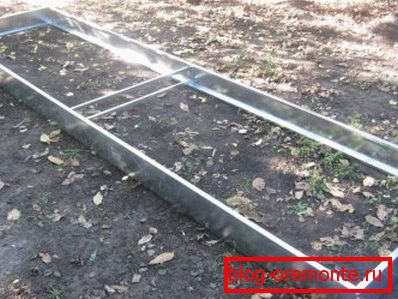
Fences without coating
Council To prevent overheating of the soil from the hot metal, the sides of the fence from the inside can be laid with cardboard or other waste material with low thermal conductivity.
- Plastic fences. If you are faced with the task of how beautifully to fence the beds or flower beds, you can use colored plastic fences. Such fences are produced in small sections of the most different forms with pointed pegs along the edges. But they are intended more for decoration than for creating high beds, since they mimic a shtaketnik with openings between the planks through which soil can crumble and water can leak.
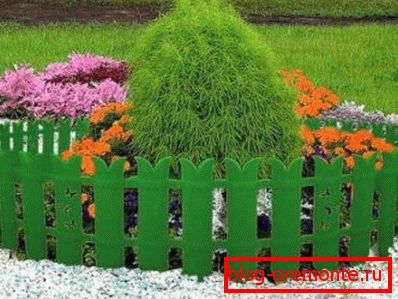
Decorative fences are more often used for flower beds.
- Plastic curbs. One of the most common and inexpensive options, allowing to make the beds of any arbitrary shape. However, it is worth noting that poor-quality curbs differ in low quality - they quickly break, especially under the influence of low temperatures. High-quality plastic for making curb tape is more expensive, but then it will last much longer.
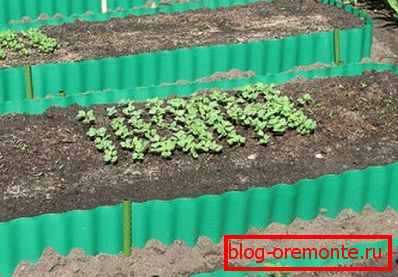
Photos of fenced plastic beds
Council To prevent the curb from arching under the pressure, reinforce it with small supports — wooden or metal pegs.
- Pergons. Option of fencing of stone beds Pergon - one of the most spectacular and elegant. It is hardly appropriate to plant potatoes or pumpkins in them, but flowers, berries, greens or cherry tomatoes in a stone frame will decorate not only the garden, but also the area in front of the house.

Pergons are metal mesh frames filled with stone or other similar material.
Homemade fencing
Each of us in the country has remnants of building materials and other unnecessary things that can be used to make a fence for the beds with their own hands. Thus, it is possible to get rid of excess rubbish and even benefit from it.
Here are the most common solutions:
- Slate. Today, many are removing from the roofs an old slate roof, changing it to more modern surfaces. Flat or wavy asbestos-cement sheet can be cut with a grinder into strips of the same width and used as borders. However, you should know that the fence for the beds of slate is not very strong, especially if the material is not new.
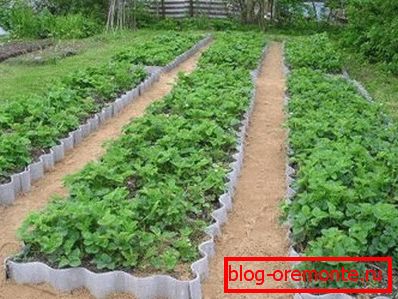
Corrugated slate borders
Attention! Asbestos sheets emit substances harmful to health, especially when heated. Keep this in mind when arranging the beds.
- Tree. You can use any lumber: edged and unedged board, slab, shtaketnik, slats, wall paneling, timber. A wooden fence can be made in the form of a box without a bottom or separate shields with pegs for installation in the ground.

Self-made wooden box
Council Since wood is a short-lived material, especially in such operating conditions, when it constantly comes into contact with wet soil, then before enclosing the beds at a dacha, treat it with an antiseptic. It does not interfere with the treatment with anti-tree borers.
- Professional sheet, sheet metal. The remains of roofing iron, corrugated board, trim metal corner or wooden pegs - all that is needed for the assembly of homemade metal fences. They, as well as wooden, can be made whole or collapsible.
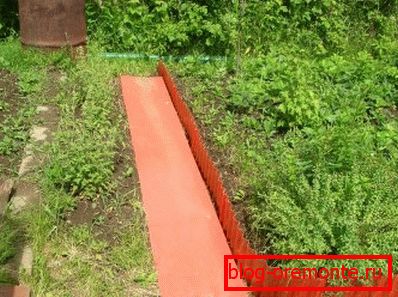
Here the profiled sheet cut across stiffeners is used as a flexible curb tape.
- Plastic panels, plastic lining. This inexpensive wall covering material can also be used as a fence for garden beds. Its drawbacks are the same as those of plastic borders: low strength, brittleness. The easiest way is to fasten wooden pegs every 50-60 cm to the panels with self-tapping screws, and stick them into the ground. For the winter, such a fence should be removed in a shed or hozblok.
- Brick, stone, concrete. A rather costly and time-consuming solution, besides the beds are stationary. But then you once and for all solve the problem of landscaping the garden.

The sides can be laid out of brick, stone or made of concrete using formwork
- Glass or plastic bottles. If there are neither listed materials, nor money for their purchase, how can we fence the beds? Bottled in the ground around its perimeter! Mega budget option that does not require any costs at all. Of course, it is difficult to immediately find the right amount of bottles, but in the country they usually accumulate quickly. In addition, you can walk to the neighbors and friends.
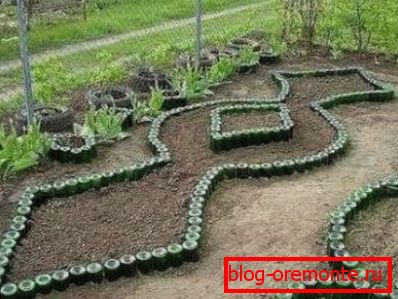
The shape and size of the beds can be any
Council When using plastic bottles, they need to be filled with earth or sand, so that they do not lose shape and stay well in the ground.
If you wish, you can find other options, we told only about the most popular and often used.
Conclusion
As you can see, the fence for the beds and flower beds are different, but they all help optimize the work of summer residents and make the site more beautiful and well-groomed. If you are interested in this topic, in the presented video in this article you will find additional information on it.